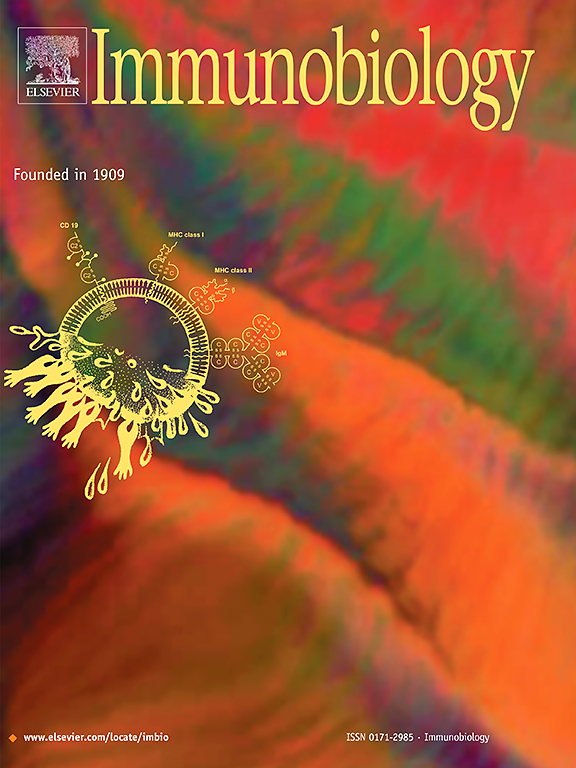uni -77靶向MCL-1激活线粒体自噬,改善小鼠牙周炎
IF 2.3
4区 医学
Q3 IMMUNOLOGY
引用次数: 0
摘要
目的探讨骨髓细胞白血病1蛋白(Myeloid Cell Leukemia 1 protein, MCL-1)抑制剂UMI-77通过线粒体自噬激活对实验性小鼠牙周炎的治疗和改善作用,重点比较给药途径(局部/腹腔)和剂量(高/低/联合)。方法将54只雄性C57BL/ 6j小鼠建立结扎性牙周炎模型,随机分为9组(每组6只):正常对照组(Aa组)、牙周炎模型组(Ab组)、阳性对照组(Ac组,局部米诺环素)、局部PBS对照组(Ad组)、腹腔PBS对照组(Ae组)、局部高剂量UMI-77 (Ba组,2mg /kg)、局部低剂量UMI-77 (Bb组,1mg /kg)、腹腔注射UMI-77 (Ca组,2mg /kg)、腹腔注射UMI-77 +局部米诺环素(Cb组,2mg /kg +米诺环素标准方案)。结果包括牙周探诊出血(BOP)、显微ct观察的牙槽骨吸收、组织病理学分析(HE/亚甲基蓝染色)、MCL-1表达(Western blot)、自溶酶体检测(透射电镜,TEM)和全身器官安全性(HE染色)。结果与模型组相比,所有uni -77治疗组的牙周炎症和骨吸收均有显著改善(p < 0.0001)。局部高剂量uni -77 (Ba组)效果最显著,BOP降低76%(0.67±0.5比Ab: 2.8±0.4,p < 0.001),牙骨质牙釉质连接-牙槽骨嵴距离降低48.7%(0.20±0.04 mm比Ab: 0.41±0.05 mm, p < 0.0001),优于阳性对照组(Ac组,BOP: 2.17±0.4,p < 0.001)。组织学分析显示,Ba组炎症细胞浸润减少,牙周纤维组织整齐。Western blot证实Ba组MCL-1表达下调至接近正常水平,TEM检测到Ba组和Ca组均有自溶酶体,表明自噬激活。系统安全性评估显示,Ba组只有轻微的1级心间隔增厚,Ca组只有短暂的脾淋巴细胞升高,没有严重的器官毒性。结论umi -77对小鼠牙周炎具有明显的治疗和改善作用,局部大剂量给药(Ba组)效果最佳。腹腔注射UMI-77联合局部米诺环素(Cb组)取得了与高剂量局部UMI-77相当的结果,突出了潜在的联合策略。这些发现表明uni -77是一种通过mcl -1靶向线粒体自噬激活治疗牙周炎的有希望的药物。临床意义umi -77,特别是局部大剂量给药,为牙周炎治疗提供了一种新的、潜在的有效和安全的方法,具有很大的临床应用前景。本文章由计算机程序翻译,如有差异,请以英文原文为准。
UMI-77 targets MCL-1 to activate mitophagy and ameliorate periodontitis in mice
Objective
To investigate the therapeutic and ameliorative effects of the Myeloid Cell Leukemia 1 protein (MCL-1) inhibitor UMI-77 on experimental murine periodontitis via mitophagy activation, with a focus on comparing administration routes (local/intraperitoneal) and doses (high/low/combined).
Methods
A ligature-induced periodontitis model was established in 54 male C57BL/6 J mice, randomized into 9 groups (n = 6 per group): normal control (Group Aa), periodontitis model (Group Ab), positive control (Group Ac, local minocycline), local PBS control (Group Ad), intraperitoneal PBS control (Group Ae), local high-dose UMI-77 (Group Ba, 2 mg/kg), local low-dose UMI-77 (Group Bb, 1 mg/kg), intraperitoneal UMI-77 (Group Ca, 2 mg/kg), and combined intraperitoneal UMI-77 + local minocycline (Group Cb, 2 mg/kg + standard minocycline regimen). Outcomes included periodontal bleeding on probing (BOP), alveolar bone resorption via micro-CT, histopathological analysis (HE/methylene blue staining), MCL-1 expression (Western blot), autolysosome detection (transmission electron microscopy, TEM), and systemic organ safety (HE staining).
Results
All UMI-77 treatment groups exhibited significant amelioration of periodontal inflammation and bone resorption compared to the model group (Ab, p < 0.0001). Local high-dose UMI-77 (Group Ba) demonstrated the most potent efficacy, reducing BOP by 76 % (0.67 ± 0.5 vs. Ab: 2.8 ± 0.4, p < 0.001) and cementoenamel junction–alveolar bone crest distance by 48.7 % (0.20 ± 0.04 mm vs. Ab: 0.41 ± 0.05 mm, p < 0.0001), outperforming the positive control (Group Ac, BOP: 2.17 ± 0.4, p < 0.001). Histological analysis showed reduced inflammatory cell infiltration and organized periodontal fibers in Group Ba. Western blot confirmed downregulation of MCL-1 expression to near-normal levels in Group Ba, while TEM detected autolysosomes in both Group Ba and Group Ca, indicating mitophagy activation. Systemic safety assessments revealed only mild grade 1 cardiac septal thickening in Group Ba and transient splenic lymphocyte elevation in Group Ca, with no severe organ toxicity.
Conclusion
UMI-77 exerts significant therapeutic and ameliorative effects against periodontitis in mice, with local high-dose administration (Group Ba) demonstrating optimal efficacy. Intraperitoneal UMI-77 combined with local minocycline (Group Cb) achieved comparable outcomes to high-dose local UMI-77, highlighting potential combinatorial strategies. These findings establish UMI-77 as a promising agent for periodontitis treatment via MCL-1-targeted mitophagy activation.
Clinical significance
UMI-77, especially with local high-dose administration, offers a new, potentially effective and safe approach for periodontitis treatment, holding great promise for clinical translation.
求助全文
通过发布文献求助,成功后即可免费获取论文全文。
去求助
来源期刊

Immunobiology
医学-免疫学
CiteScore
5.00
自引率
3.60%
发文量
108
审稿时长
55 days
期刊介绍:
Immunobiology is a peer-reviewed journal that publishes highly innovative research approaches for a wide range of immunological subjects, including
• Innate Immunity,
• Adaptive Immunity,
• Complement Biology,
• Macrophage and Dendritic Cell Biology,
• Parasite Immunology,
• Tumour Immunology,
• Clinical Immunology,
• Immunogenetics,
• Immunotherapy and
• Immunopathology of infectious, allergic and autoimmune disease.
 求助内容:
求助内容: 应助结果提醒方式:
应助结果提醒方式:


